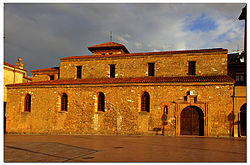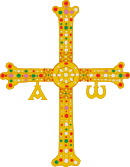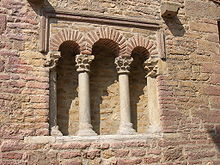- Church of San Tirso, Oviedo
-
Church of Saint Thyrsus
Iglesia de San Tirso (Spanish)
Basic information Location  Oviedo, Spain
Oviedo, SpainGeographic coordinates 43°21′43.84″N 5°50′37.56″W / 43.3621778°N 5.8437667°WCoordinates: 43°21′43.84″N 5°50′37.56″W / 43.3621778°N 5.8437667°W Affiliation Roman Catholic Province Asturias Ecclesiastical or organizational status Church Website Official Website Architectural description Architect(s) Tioda Architectural type Church Architectural style Pre-Romanesque, Romanesque Completed 9th century The Church of Saint Thyrsus (Spanish: Iglesia de San Tirso or Spanish: Iglesia de San Tirso el Real de Oviedo) is a Roman Catholic Asturian Romanesque church situated in Oviedo, in Asturias, northern Spain. Dedicated to Saint Thyrsus, it was built by Tioda, the royal architect of Alfonso II of Asturias. The Great Fire of Oviedo in 1521 and rebuilding in the 18th century removed most of the original church, except for a three-light window.
Building
The building has suffered so much from alterations over the centuries and only the general plan has been preserved. It is that of a basilica with nave and aisles divided by rude stone piers set at unequal intervals, from which round arches spring. In the easternmost bay, however, owing to the smaller span, the arch was made sufficiently pointed to raise its crown to the same height as the others. This irregularity was already typical of Imperial Roman times, when barrel vaults were given a pointed form in order to make the height of rooms of varying size uniform, as it was necessary to raise the crown of the vault in some of them. This is illustrated by various chambers in the House of Tiberius on the Palatine [1].
There is no satisfactory explanation of the "many angels" the building is said to have presented in the Codex Vigilianus.
In the rectangular sanctuary atriplet round-arched window (2 by 2 metres (6.6 × 6.6 ft) is preserved. With its pre-romanesque bases, rough brick arches, and capitals with rude packed leaves, it gives an idea of the better style of building and carving in the time of Alfonso II of Asturias. It is known that the church of San Tirso housed Royal Chapel [2].
Notes
- ^ Rivoira 1918, p. 335
- ^ Redondo Cadenas 1976, p. 609
References
- Redondo Cadenas, Feliciano (1974). "La iglesia de San Tirso el Real de Oviedo I: su pasado y presente" (in Spanish) ([dead link]). Boletin del Insituto de Estudios Asturianos 29 (81): 171–183. ISSN 0020-384X. http://tematico.asturias.es/cultura/ridea/ConsultaBoletines/PDFs/081-09.PDF.
- Redondo Cadenas, Feliciano (1976). "La iglesia de San Tirso el Real de Oviedo I: basílica primitiva" (in Spanish) ([dead link]). Boletin del Insituto de Estudios Asturianos 30 (88-89): 607–626. ISSN 0020-384X. http://tematico.asturias.es/cultura/ridea/ConsultaBoletines/PDFs/088-08.PDF.
- Redondo Cadenas, Feliciano (1976). "La iglesia de San Tirso el Real de Oviedo III: La torre y sus alrededores" (in Spanish) ([dead link]). Boletin del Insituto de Estudios Asturianos 31 (90-91): 343–362. ISSN 0020-384X. http://tematico.asturias.es/cultura/ridea/ConsultaBoletines/PDFs/090-12.PDF.
- Rivoira, Giovanni Teresio (1918). Moslem architecture : its origins and development. London: Oxford University Press. http://www.archive.org/details/moslemarchitectu00rivouoft
Pre-romanesque art in the Kingdom of Asturias Pre-Romanesque art in Asturias is framed between the years 711 and 925, the period of the rise and extension of the Kingdom of Asturias.Architecture 1st Period (737 to 791)2nd Period (791 to 842)3rd period (842 to 866)Church of Santa María del Naranco • Church of San Miguel de Lillo • Church of Santa Cristina de Lena4th period (866 to 910)5th period (910 to 925)
Infrastructure La FoncaladaMajor figures Minor arts Spiritual legacy Categories:- 840s architecture
- Buildings and structures in Oviedo
- 9th-century church buildings
- Churches in Asturias
Wikimedia Foundation. 2010.

